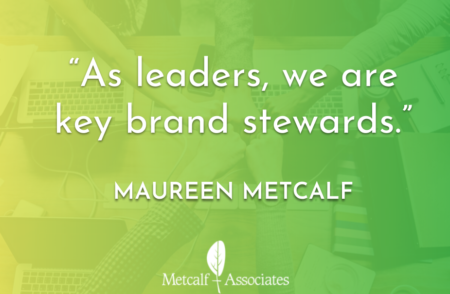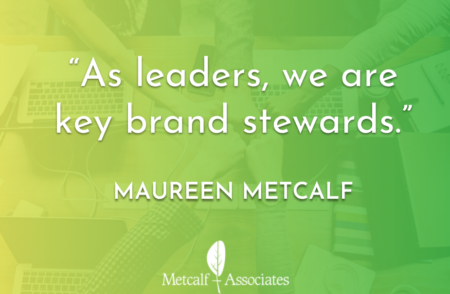
This post is from a Forbes article written by Maureen Metcalf in collaboration with Brad Circone. It is the companion to a Voice America interview with Brad, From Banding to Branding: How the Wisdom of Rock n Roll taught The Artful Discipline of Leadership on the Voice America Radio Show, “Innovative Leaders Driving Thriving Organizations” on December 5, 2017.
Given the pace of change across industries, and specifically, the pace of change leaders are required to personally keep, do you refresh your brand as your ecosystem changes? And do you, as a leader, live that brand?
A brand can be one of the biggest differentiators for an organization, whether positive or negative. It impacts what feelings are evoked when people interact with a product. Some of the most successful brands, like Google and Apple, invest a great deal in defining and living out their brand.
Brand equity often drives revenue, customer retention and price. Everyone in the company should live the brand. As leaders, we are key brand stewards — it is critical for us to have a clear picture of what the brand is, how it behaves and to humbly respect it enough to follow it. Your brand runs your company too.
1. Identify your organization’s mission, vision and guiding principles.
As leaders, we use these as the basis for all decisions. Here’s the guiding principle of a public radio station in Columbus, Ohio, of which I’m a board member: “This station will be the home of creativity and innovation in all forms of audio content — journalism, music, fiction, culture, and art — regardless of platform. We’ll accomplish this by helping every colleague explore and achieve his or her full potential, all in the service of bolstering our community and improving humanity.”
This purpose is grounded in action by leaders who use a set of behavioral guidelines and agreements that support making this possible. One key area of focus is seeing the best in everyone on the team and promoting experimentation.
2. Position the brand.
Determine how to position the company and the subsequent brand offering to evoke the feelings you want people to experience when they interact with you.
In the case of the public radio station above, its leaders selected the brand based on both internal capabilities and the gap they saw in the market. The station regularly hears from listeners who say they support the news hour and that the local content keeps them informed and connected. They also hear from local musicians who say the airtime they got launched their successful careers when others would not give them a chance. They are experimenting with several elements of funding and content to remain valuable.
When talking about the feelings they want their listeners to experience, leaders’ goals include: a feeling of connectedness at home and in the community, feeling intellectually challenged and informed and a feeling that they, too, can experiment to accomplish greater results in their lives. They want to inspire the community to grow and evolve.
3. Personalize the brand’s attributes.
If your brand was a person, who would that person be and what would they do? Leaders must take the perspective of their brand avatar when making key decisions.
As the founder of a coaching firm, our avatar is now evolving to reflect the leadership team, and more importantly, the brand our clients want that will inform our actions and preserve our promises. As change accelerates, leaders are feeling increasingly overwhelmed.
Having an external thought partner and advisor who works confidentially and addresses their biggest challenges gives a sense of support and confidence. We call this avatar “The Brand of Yoda.” Yoda prepared Luke to fight the Dark Side. He was eminently wise, able to teach complex skills and thinking, and he was supportive and tough. Luke not only had different skills, he was significantly more effective because he saw himself and the world differently.
4. Amplify leadership behaviors and internalize the brand message.
To ensure leaders consistently live the brand, it is critical that they understand and amplify the behaviors they expect from not only themselves but everyone in the organization. Once brand attributes are clear, it is important to identify how one lives the brand.
Our company is committed to transforming leaders, therefore, each member lives the brand as Yoda, supporting client transformation. This behavior requires foundational agreements about how our team members and our strategic partners operate to ensure we reinforce the agreed-upon brand platform.
5. Activate external messaging.
Once leaders know how to live the behaviors called forth by the brand, it is important to clarify external messaging and activate it. This is where knowing becomes doing.
How do you convey your differentiation, the value you add, and create the feeling you want to evoke? It is important that all brand image elements and content are immutably aligned, from written to visual to behavioral. This messaging is informed by each prior step.
We, for example, are currently updating our own materials to convey our balance between leading, thinking and research, and the personal connections we create with our clients to help them make the changes they seek. This must be activated through our brand at every touch, relentlessly.
As a leader, if you are trying to amplify the value of your company by leveraging the brand, it is critical that you live it and lead others to do the same. Irrespective of an employee’s role within the company, they represent the brand. When one associates them with their role within the company, they are representing the brand and therefore help control and determine its ability to be loved or be left quietly alone.
Are your leadership behaviors increasing brand equity and building on the feeling you want your customers to have when they interact with your organization?
As a reader of this blog and listener to the interviews, please consider enrolling in one of the innovative leadership online leader development program. For additional tools, we recommend taking leadership assessments, using the Innovative Leadership Fieldbook and Innovative Leaders Guide to Transforming Organizations, and adding coaching through our online innovative leadership program. We also offer several workshops to help you build these skills.





